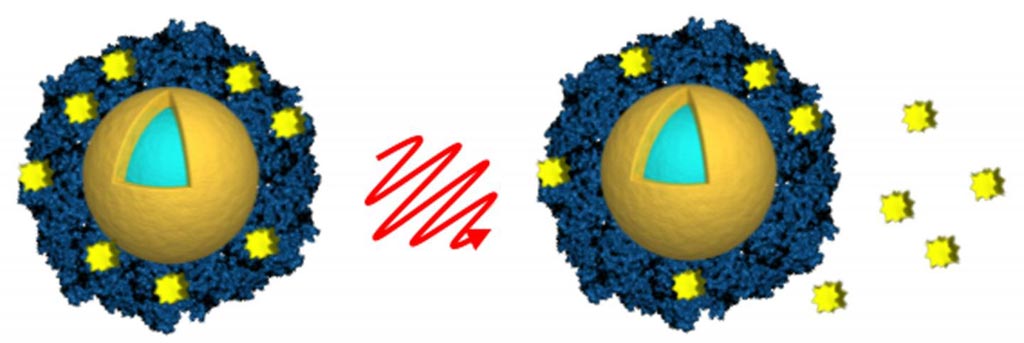Gold Nanoshells Safely Deliver Toxic Chemotherapeutic Drugs
By LabMedica International staff writers
Posted on 21 Nov 2017
A novel method for delivering toxic drugs to tumor cells relies on the use of light-activated gold nanoparticles, which are triggered remotely by laser light to release the drugs inside the cancer cells.Posted on 21 Nov 2017
Nanoparticle-based drug delivery systems provide a highly promising approach for localized drug delivery and are an emerging field of interest in cancer treatment. In this regard, investigators at Rice University (Houston, TX, USA) and Northwestern University (Evanston, IL, USA) demonstrated the near-IR (infrared) light-triggered release of the chemotherapeutic drugs docetaxel - from a nanoshell-based DNA host complex - and lapatinib - from nanoshell-based DNA and human serum albumin host complexes.

Image: Investigators loaded light-activated nanoshells (gold and light blue) with the anticancer drug lapatinib (yellow) by encasing the drug in an envelope of albumin (blue). Light from a near-infrared laser (center) was used to remotely trigger the release of the drug (right) after the nanoshells were taken up by cancer cells (Photo courtesy of A. Goodman, Rice University).
The investigators reported in the November 6, 2017, online edition of the journal Proceedings of the [U.S.] National Academy of Sciences that, depending upon the drug molecule, the type of host molecule, and the laser illumination method (continuous wave or pulsed laser), in vitro light-triggered release could be achieved with both types of nanoparticle-based complexes. Two breast cancer drugs, docetaxel and HER2-targeted lapatinib, were delivered to MDA-MB-231 and SKBR3 (overexpressing HER2) breast cancer cells and compared with release in noncancerous RAW 264.7 macrophage cells.
Continuous wave laser-induced release of docetaxel from a nanoshell-based DNA host complex caused increased cell death, which also coincided with nonspecific cell death from photothermal heating. Using a femtosecond pulsed laser, lapatinib release from a nanoshell-based human serum albumin protein host complex resulted in increased cancerous cell death while noncancerous control cells were unaffected. Both methods represented localized drug-release strategies that could facilitate high local concentrations of chemotherapy drugs deliverable at a specific treatment site over a specific time window, with the potential for greatly minimized side effects.
"In future studies, we plan to use a Trojan-horse strategy to get the drug-laden nanoshells inside tumors," said senior author Dr. Naomi Halas, professor of biomedical engineering at Rice University. "Macrophages, a type of white blood cell that's been shown to penetrate tumors, will carry the drug-particle complexes into tumors, and once there we use a laser to release the drugs."
"Getting chemotherapeutic drugs to penetrate tumors is very challenging," said contributing author Dr. Susan Clare, research associate professor of surgery at Northwestern University. "Drugs tend to get pushed out of tumors rather than drawn in. To get an effective dose at the tumor, patients often have to take so much of the drug that nausea and other side effects become severe. Our hope is that the combination of macrophages and triggered drug-release will boost the effective dose of drugs within tumors so that patients can take less rather than more."
Related Links:
Rice University
Northwestern University














